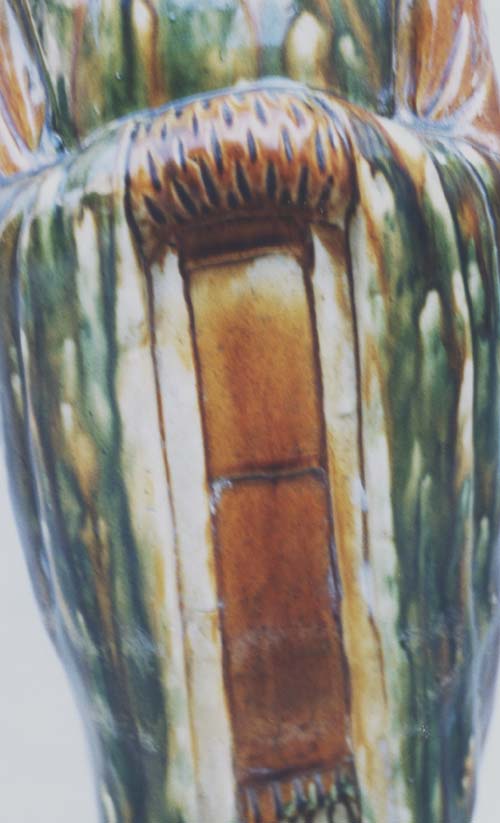|
|
 |
|
Tang Court Official (Private Collection) |
|
A
1000 YEAR OLD TANG DYNASTY
The Tang emperor successfully unified China in 618 A.D., and when it came to the reign of the second Tang emperor, Taizong that we saw an ever expanding China that brought prosperity and peace to its people. The study of pottery has a bearing on political and economic aspects of the Tang period, as well as on its artistic and technological history to a degree unequalled at other times. On the site of the Bei Mang mountain of Loyang, where a huge number of Tang tombs were dug out in 1905 for the construction of a rail way, and the flamboyant tricolour (sancai) jars, bottles, animals such as horses and camels, zhenmushou (beast guarding the tomb) and figurines were unearthed, which revealed the treasures of the Tang Dynasty cultural relic. Undoubtedly, the incentive that prompted the making of ceramic vessels to substitute the precious metal models for burial purpose was a fashion then. Officials in general have vied with each other in funeral ostentation. Statues of people and horses were made quite life like. This custom became general and extends to the common people. |
|
|
 |
|
Tang Court Official (Private Collection) |
| The figure of
the court official is ideally represented in the form of a civil officer
in the Tang dynasty, and is apparently clean-shaven unlike the Sui
Dynasty model that usually shows a bearded man. The Tang official has
broad embroidered hems around the openings of the sleeves, the ornament
being roughly suggested by dappled colour in the prevailing sancai
fashion. With his hands clasped, the face is naturally serene and
conforms better to the Tang standards of true portraiture. The cap of
the court officials are always exaggerated in height and their wings
turned into the semblance of a bird. The courtier is always moulded to
stand at attention, made in buff earthenware with white slip and
transparent three-colour lead glaze and found in Loyang, Gong county of
Henan, and Xian of Shaanxi. The sancai pieces are products fired at a
low to medium temperature in the range of 850 to 900 degrees centigrade.
Imitation of the Tang horses and figurines were rife in the early twentieth century when the Europeans especially connoisseurs from England started buying in bulk of such sancai pieces at an exorbitant price. The antique dealers cashed in on this opportunity by engaging a group of potters to set up kilns for the making of Tang pieces. They produced a lot of such fakes which were purposely broken at the legs or other protruding parts and reattached again with the colour scrapped to show a worn out appearance. The crackers over the surface are unnatural and totally different from the housefly wing pattern appeared in the genuine wares. The skill in the handling of the Chinese brush is also a clear characteristic in the authentication of a good court official figurine. The painting of the pigment onto the body of the figurine accompanied some practice of Chinese writing, so that with it went a habit of calligraphic mannerism in decorative details. The pigments were applied freely with the use of a Chinese brush, as this is the only way to ensure that the different pigment colours would not mingled into a mess with the colours well separated. We therefore notice that the centre of the body trunk shows a matted colour surface as the painter can only hold the brush in the zhong feng style (with the tip of the brush upright and straight ) when painting this part so as not to dirty the sleeves and the edges. As a result, the glaze would be thinly applied and largely absorbed by the clay and the slip. Whereas in the fakes, we do not find any brushing lines or uneven markings on |
| the
surface. The modern method has forgo the hand painted
style for reason of commercial benefit as the imitators would want a
large quantity of wares to be produced to reap the greatest earnings.We would also find a
crack
mark lining the waist area that joins the upper and lower parts of the
body trunk of the figurine, which is a tell tale sign of the moulding
pattern. The up-down style of joining fits well with the principle of
force and heat expansion as on firing, the clay would expand and exert a
shearing force at the sides which usually causes the object to stumble
and collapse especially when the figurine being fired is placed upright
and tall. If instead we set the mould in a vertical manner and seal the
joint horizontally, the gravitational force would help merge the two
parts of the figurine tightly when heated. This reflects the wisdom of
the Tang potters and provides a clue for our easy identification.
We learn to authenticate so as not to be fooled and cheated by the unscrupulous dealers, as it will not just mar our reputation, but also incur gigantic financial loss if we wish to purchase it for collection. Written by: Mr Lim Yah Chiew (28 Mar 02)
|